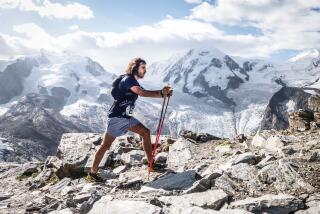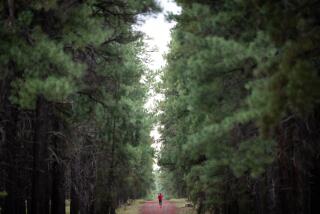A spiritual experiment of marathon proportions
MT. HIEI, JAPAN — In Japan, Buddhist monks wear black. Dead people wear white.
For more than seven years, Genshin Fujinami dressed in white from head to toe while covering the backwoods trails of this sacred mountain in one of the world’s most grueling feats -- a punishing quest that combined starvation, isolation and the equivalent of a lap around the equator.
For 1,000 days, rising well before dawn, Fujinami embarked alone, rain or shine, on his journey, running or briskly walking more than 50 miles -- that’s almost two marathons -- each day as the trial neared its climax. Along with his white robes, his only gear was a pair of straw sandals, a long straw hat, candles, a shovel, a length of rope and a short sword.
The rope and sword weren’t for survival: If for some reason he could not complete his daily trek, he was to use them to kill himself.
“I would have chosen the rope over the knife because it’s faster and cleaner. But, fortunately, it rarely comes to that,” Fujinami, a stout man with a shaven head, said at a small temple deep in the mountains where he is now an abbot. On the wall behind him was a scroll with a painting of Fudo Myo-o, his guardian god, who normally is portrayed with a fearsome scowl, a raised sword and a backdrop of leaping flames.
Since 1885, only 48 “marathon monks” of Buddhism’s Tendai sect have accomplished the ritual. Those who do earn the title of “dai-ajari,” or living saint. Of the monks who attempted the trial, at least one is known to have killed himself in modern times, Fujinami said.
The quest dates to the 8th century and is believed to be a path to enlightenment.
Monks carry a little book of prayers and incantations, which they offer at about 300 temples and sacred spots along the way. Other than that, they don’t stop for breaks.
“You don’t go on the trails to train; you go to offer prayers,” Fujinami said. “Athletes do it for awards. We do it to grow spiritually.”
His spiritual training began when he became a monk at 19.
“I had a regular job before that, but I decided I wanted to join a monastery and think about my life,” he said. “I think I found something that fits me well.”
For many years, he lived a routine life, studying the sutras and teachings of Buddha. But at 34, he decided to undertake the most rigorous path his sect had to offer.
Two years later, he took his first steps.
“I didn’t really train first,” he said. “I just went out to learn the trails. Then I was off.”
A strict regimen dictates that in each of the journey’s first three years, the pilgrim must rise at midnight for 100 consecutive days to pray and run along an 18-mile trail around Mt. Hiei, on the outskirts of the ancient capital, Kyoto. Fujinami left his temple at 1 a.m. and returned about nine hours later to spend the rest of the day praying, cleaning or doing other chores.
He slept three or four hours a night.
In the next two years, he had to extend his runs to 200 days. In the winter, the pilgrim runner gets to take a break.
Fujinami said the time spent on the trails is spread out over seven years -- not because of the rigors, but to allow for time to reflect.
“You learn how to see your real self,” he said. “You learn to understand what is important and what isn’t.”
Fujinami said his most difficult trial came during the fifth year, when he had to sit in the lotus position before a raging fire and chant mantras for nine days without food, water or sleep in an esoteric ritual called “doiri,” or “entering the temple.”
After 330 prostrations, the monk repeats a mantra to Fudo Myo-o 100,000 times. Two attendants take turns being with him before the altar to keep watch, making sure he doesn’t stop, fall asleep or pass out. On the fifth day, the monk is allowed to rinse out his mouth, but not to swallow the water.
“You can only do this after preparing,” he said. “After about four days, you really start to lose your strength and your clarity. You stop caring about anything. But you have to keep sitting upright and repeating the mantras.”
In the sixth year, Fujinami covered 37 1/2 miles every day for 100 days. And in the seventh year, he went 52 1/2 miles for 100 days and then 18 miles for another 100 days.
“There are times when you fall into a slump and just don’t want to go on,” he said. “It’s hardest in the summer. You wonder why you have to suffer like this.”
Fujinami ran his last circuit in 2003 -- when he was 44.
The quest has earned Fujinami the respect of extreme athletes around the world.
One of them is Dave Ganci, who wrote about the monks in Trail Runner magazine and has trained special forces, including Navy SEALs, for the U.S. military.
“I have been out on the thin edge of heat, cold, fatigue, starvation and dehydration stress many times and to the point where I had to play mental games with my body to keep it moving,” Ganci said in an e-mail from his home in Arizona, where he teaches survival skills.
“I still cannot identify with the marathon monks’ regimen and how they accomplish their feats by any physical definition,” he said. “It has to be a mental quality that carries them through the pain, fatigue, thirst, hunger, heat, cold and whatever dragons they meet on the trail.”
More to Read
Sign up for Essential California
The most important California stories and recommendations in your inbox every morning.
You may occasionally receive promotional content from the Los Angeles Times.










